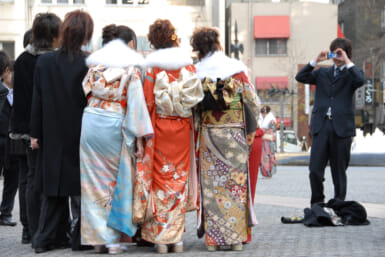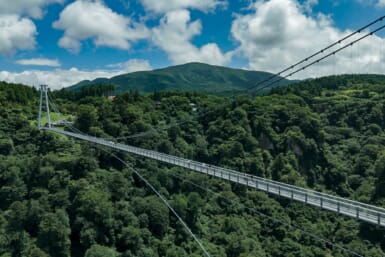by Elyse M. Rogers
ORIENTAL MEDICINE
Few of us live in Japan for very long without becoming curious about Oriental Medicine. Not only do we see signs along Tokyo streets pointing out acupuncturists or shiatsu practitioners or read articles on the different types of Oriental medicine, but many of us have Japanese friends who have received treatments from Oriental Medicine practitioners. Often, these friends claim they’ve had miraculous relief from pain or been cured of various ailments.
Because I’ve had requests from readers on the subject of Oriental medicine and Oriental medical practitioners, and because of my own interest in finding out more about the type of special medicine often practiced in Japan and Asia, I’m currently doing some research on the subject and planning interviews with Oriental medicine specialists. So, watch for future columns dealing with practitioners or general information on Oriental medical subjects.
Oriental medicine includes a wide range of practices but the basic theory is the same. I thought it might be helpful, therefore, to give some general information about the subject. Keep in mind that I am a reporter and researcher in these matters and not an official (or even unofficial) expert.
Also, remember that although I have a healthy respect for Oriental medicine and other Eastern practices and philosophies (which you’ll realize when you read this column and others), I come from a Western medical background and am a product of Western medical/health thinking.
With those ground rules established, let’s get into this fascinating subject of Oriental medicine.
YIN/YANG
Oriental medicine is certainly not some Johnny-come-lately type of fad, as most of you know. It originated in China about four or five thousand years ago and was introduced to Japan about 250 B.C. The classic volume called Nei Ching (The Yellow Emperor’s Canon of Internal Medicine) is considered the basis of Oriental medicine. In the Nei Ching it’s written that “The principle of Yin and Yang is the basic principle of everything in creation…”
Thus the law of Yin and Yang plus the law of The Five Elements are considered the “absolute and fundamental laws of Oriental philosophy and it is upon those laws that Oriental medicine is based.” (Quoted from the book Japanese Acupuncture by Mme. Dr. M. Hashimoto.)
The two opposing bodily forces of harmony are called Yin and Yang. But Yin and Yang are not only in the body, they are the principle of everything in creation. Yang is considered the light element, and Yin the dark, or Yang the positive and Yin the negative. Everything has both elements and all is relative.
In addition to the two forces of nature (Yang-Yin or Active-Passive) there is a further division in which all that exists is classified according to the Five Elements which are Wood, Fire, Earth, Metal and Water. (For example, the liver, the bladder, the eyes, the nails, tears and acids are all included in the “Wood” category.)
Since the body is a part of nature, the idea is that the human body has the same type of force structure as the rest of the world. And, by bringing the bodily forces (Yang-Yin) into proper balance, health is restored because energy flows freely along the meridians which are invisible channels or pathways in the body.
If you thought that ended the divisions, think again. Seems there are two principal cycles among the five elements —the Kо and Sheng cycles. The Sheng Cycle is based on the idea that each element is the engenderor (mother) of another element (such as that Fire engenders earth); the Ко Cycle is based on the idea that each element overcomes another element (such as water overcomes fire by extinguishing it).
Energy is considered an important force in the body and plays a big part in the whole concept. The essence of energy or the life-force is called ki in Japanese. The energy force of the body should be in balance, and either hyperactivity or hypoactivity in any part can cause disharmony and illness.
Although all factors are important in disease, Oriental medical practice believes that basically diseases are caused by either interior or exterior causes. Exterior causes are related to the Five Perverse Climates, and their adverse effects are in the category of kan or chu. Kan is a condition of lesser intensity which causes minor diseases such as colds, while chu is a condition of greater intensity which causes the serious diseases such as hemorrhage.
The interior causes are related to the psychic stress generated by the Five Emotions. And excess of emotional stress can effect individual organs and the entire body.
If that sounds complicated, it is. And experts get into the fascinating and complex subjects of the 12 channels, the 15 collaterals, principal cycles of Ko and Sheng, and the Tsang and Fu organs, etc.
ACUPUNCTURE THEORY
“Acupuncture” is a word derived from the Latin word “acus” which means needle, and the English word “puncture” that we all know. In Chinese, acupuncture is called zhenjiu and in Japanese it’s called hari. The term acupuncture actually includes not only needles placed at acupoints, but also includes a process called moxibustion which is the burning of cones of dried medicine (artemisia vulgaris) at the same acupoints. But, for most foreigners, acupuncture is throught of as a “needle” technique, so I’ll use the term in that context.
Acupoints on the body are very specific and are not random as they might appear. The points are based on body “meridians” which are pathways of the body through which “ki” (sometimes called qi or chi) or energy passes. When these energy paths are working correctly, the body is in harmony or in good health. However, if the bodily forces are blocked in some way or thrown off balance, diseases or illness can occur.
BODY AREAS AND MERIDIANS
In order to work in a more organized fashion with the bodily forces of yin and yang, the ancient Chinese doctors divided the body’s functions into three distinct areas—each with a yin and yang function. The three are labeled as follows:
- Sunlight yang/greater yin.
- Lesser yang/absolute yin.
- Greater yang/lesser yin.
Which meridian services these sections, and what organs are included, are things the acupuncture specialist must learn in his studies, as every Chinese medicine practitioner must have a complete grasp of the meridian system. The linkage of meridians with other areas in the body and with the exterior is important. The main meridians are 12 major (sometimes called regular or jing meridians), and eight “extra meridians.”
For example, the Leg Absolute Yin Meridian, referred to in practice as the “liver meridian,” runs from the end of the big toe, along the leg and up into the center of the torso.
The paths of the meridian, like the points along them (acupoints), have changed little since ancient times. In fact many Oriental medicine practitioners still use the old chart from the Nei Ching in daily practice. You may have seen meridian charts posted on walls in doctors’ offices or in books, but the pathways look like nerve networks (or fine dark threads) that crisscross every part of the body.
Oriental medicine recognizes 59 meridians and up to 1,000 acupoints, although most charts show only 365 acupoints, (though different books give different numbers) but most practitioners work with only about 150 points in actual practice. And, the skilled practitioner recognizes that although specific points may have a specific relationship to one organ or part of the body, all systems must be in harmony in order for good health or proper healing lo take place.
In summary, the total understanding of the interconnections and interrelationships between substances, meridians, organs and the forces of nature arc the core of the practice of all types of Chinese or Fast Asian medicine, including acupuncture.
Acupuncture is used for a variety of ills and discomforts, and even as a kind of preventive medicine tool Some believers take acupuncture treatments on a regular basis throughout life, simply to keep their bodies “in tune.”
Although much about Chinese medicine has long been known in the West, in the 1970s interest in acupuncture was dramatically heightened after President Nixon brought reports about it back from his first trip to China, and after Western doctors visited China and witnessed surgery performed on patients whose only anesthesia was acupuncture.
Acupuncture anesthesia, by the way, is still used in China and in Japan for some types of surgery, I’m told.








